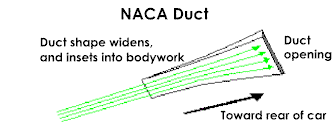AIR SCOOP HYPOTHESIS |
| Written by Jon Amo | |
| Sunday, 07 January 2007 | |
| "Column of Air" Scoop Sizing Hypothesis "Column of Air" Scoop Sizing Hypothesis One of the "black arts" in any kind of racing is how to get air into the engine without starving it or producing too much drag at the top end. For a long time, now, Land Speed Racers have been using a hypothesis that says that the engine can injest a column of air that matches the engine's need if the scoop is sized just right. This becomes a fairly simple thing to determine mathematically and it works at a target speed and engine RPM. For any speed less than the target speed and at WOT the scoop size is too small and unmentionable things may happen to the motor, especially if using a carb which depends on air flow signals to meter the proper amount of fuel. I will develop the formula for sizing your scoop which will need only your engine displacement, an estimate of the engine volumetric efficiency, and the target speed you seek. Examples of the scoop size being too small will also be developed in examples. DISCLAIMERRemember, I do this for fun and the value to you, the racer, fan, or whatever is worth only what you put on it. Should you use this formulation, I would like to hear of your experiences. Assumptions and GivensI make no assumptions,in this analysis. Howeve, if you have something that you think should be included, send it to me and I'll think about it. 1) Engines are air pumps 2) CFM of air injested for a given RPM is constant. Mass of air will change with ambient conditions or boost, but, CFM does not change for a given RPM and engine size. What follows was an academic exercise for me and hopefully the answer to some of the clients questions on scoops size needed. It is not intended to be a definitive answer to anything except our collective curiosity. To that end, if you find it useful, amusing or down right distasteful,GREAT! You may find errors, wrong assumptions, or other nastiness and I will appreciate you pointing them out to me. Complaints should be backed up by real data, through either analyses of your own or documented information. I am ameniable to changing my thinking iffn there is good reason to. Opinions, by themselves, just don't cut it. Here we GO!The underlying question of sizing a scoop is how small can I make it and still feed the engine. Smallness is required because drag becomes prominent when speeds go up and air spills around the scoop opening because it is larger than needs to be. This added drag reduces the top speed of the vehicle. The foundation equation is not difficult and is easily solved. EQUATIONS CFM = (Displacement (cubic inches) * Volumetric Efficiency * RPM) / ( Speed (mph) * 2 * 1728 * 60 * 1.467) CFM(cubic feet per minute) is not a useful parameter in scoop size although it does give you an indication of how much air you are pumping and is a great starting plce for figuring carburetor (jeeze, did I spell that right?). Remember also that the volumetric efficiency is highest at the torque peak (I think!) and can in some instances be greater than 100% because of ram tuning. My advice is that unles you have something like Dyno 2000 which can give you a volumetric efficiency number for your engine parameters, then I humbly suggest that you use 90% or 0.9 in the equation. I also assume you all know how to determine the displacement of your engine? If not, email me and I'll tell you. Awww hell, it's Disp = number of cylinders times bore times bore times 0.7854 times stroke. CFS = CFM / (60) CFS (cubic feet per second) divided by the target speed in feet per second gives the scoop size in square feet. Scoop size (sq ft) = CFS / (Speed (mph) * 1.467)But let's convert this puppy to square inches by multiplying scoop size by 144 sq inches per sq ft. Scoop Size (sq inches) = Scoop Size (sq ft) * 144 sq inches per sq ftNow that wasn't too hard was it? But I will combine all the above and simplify so the math gets easier. Scoop Size (sq inches) = 0.00047338 * ( Disp * Vol Eff * RPM) / Speed (mph)EXAMPLE How big does a scoop need to be to supply a 369 cubic inch engine with a vehicle target speed of 240 mph. Volumetric efficiency of the engine at 8000 rpm is 90%. Plugging into the friendly formula and find.... Scoop Size (sq inches) = 0.00047338 * (369 * 0.9 * 8000) / 240 = 5.24 square inch opening for a motor at 8000 rpm and going 240 mph.Now what size scoop opening is needed for the acceleration phase of the speed run? Lets try the same parameters at a speed of 100 mph, WOT, same efficiency... Scoop Size (sq inches) = 0.00047338 * (369 * 0.9 * 8000) / 100 = 12.57 square inch opening for a motor at 8000 rpm and going 100 mph.So you can see the problem with using this as gosphel. If you build a sealed air box with the high speed opening, then you will be starving the engine for air at any speed less that the target speed! This will cause the air density going into the engine to be decreased and while the cfm going into the engine may be the same, the mass of ais isn't. This may cause an over rich condition or may even lean out the engine because of poor metering signals for the fuel flow. This has been a serious effort to try and determine how big a scoop needs to be to meet a given speed requirement while minimizing drag. During the analysis it was found that scoop size for a given speed and engine conditions can be deterined. but that this scoop size is inadequate for slower vehicle speeds at the same given rpm. As a get off the stage commentary, I would suggest that the very best air intake system can be found on the NASCAR Winston Cup cars: the inlet is at the base of the windshield and is a very large opening. Since it is in stagnant high pressure air, ne penality is for drag is observed, plus you get a bit of a boost! I would futher comment that the scoops which have the opening against the glass but which are also very tall and further insulting the air flow problem because the high speed air over the top of the scoop is actually sucking the air from the scoop, not the other way around. Point that puppy into the wind, boys! If you use this or a similar technique or the same methodology, just remember, your milage may vary :^}. I have been investigating the use of some 2D Computational Fluid Dynamics programs to visualize the flow in a scoop. I have found one that looks interesting, but the freebie demo only has 31 x 31 nodes for the solution matrix. I can buy the full code which has 301 by 301 nodes for a mere 300 bucks...from Japan. Maybe, I dunno... Copyright (C) 1998 - 2004, all dates inclusive, L.E. Mayfield - All Rights ReservedNACA DuctsNACA stands for "National Advisory Committee for Aeronautics". NACA is one of the predecessors of NASA. In the early days of aircraft design, NACA would mathematically define airfoils (example: NACA 071) and publish them in references, from which aircraft manufacturers would get specific applicationsThe purpose of a NACA duct is to increase the flowrate of air through it while not disturbing the boundary layer. When the cross-sectional flow area of the duct is increased, you decrease the static pressure and make the duct into a vacuum cleaner, but without the drag effects of a plain scoop. The reason why the duct is narrow, then suddenly widens in a graceful arc is to increase the cross-sectional area slowly so that airflow does separate and cause turbulence (and drag). NACA ducts are useful when air needs to be drawn into an area which isn't exposed to the direct air flow the scoop has access to. Quite often you will see NACA ducts along the sides of a car. The NACA duct takes advantage of theBoundary layer, a layer of slow moving air that "clings" to the bodywork of the car, especially where the bodywork flattens, or does not accelerate or decelerate the air flow. Areas like the roof and side body panels are good examples. The longer the roof or body panels, the thicker the layer becomes (a source of drag that grows as the layer thickens too). Anyway, the NACA duct scavenges this slower moving area by means of a specially shaped intake. The intake shape, shown below, drops in toward the inside of the bodywork, and this draws the slow moving air into the opening at the end of the NACA duct. Vortices are also generated by the "walls" of the duct shape, aiding in the scavenging. The shape and depth change of the duct are critical for proper operation.  all i can do is try to take this stuff in as helpful information but not as a solution... |
